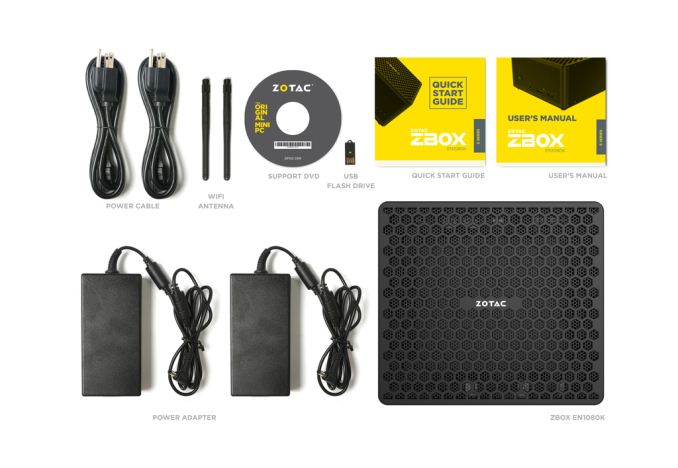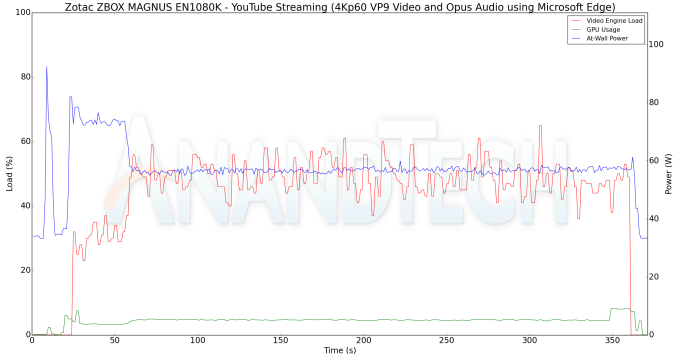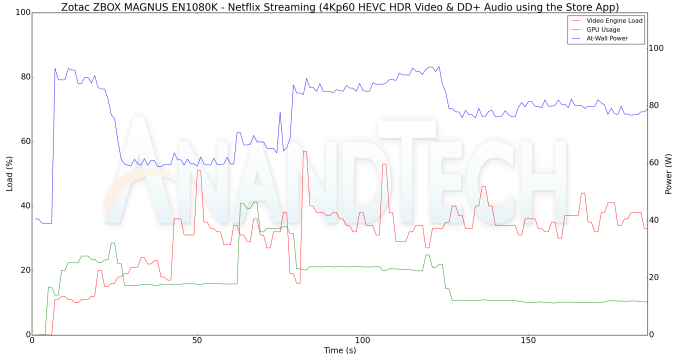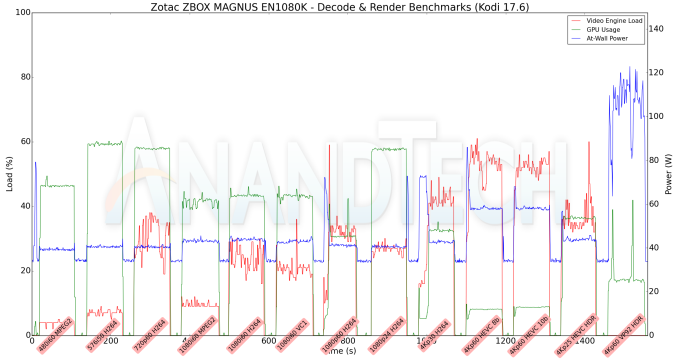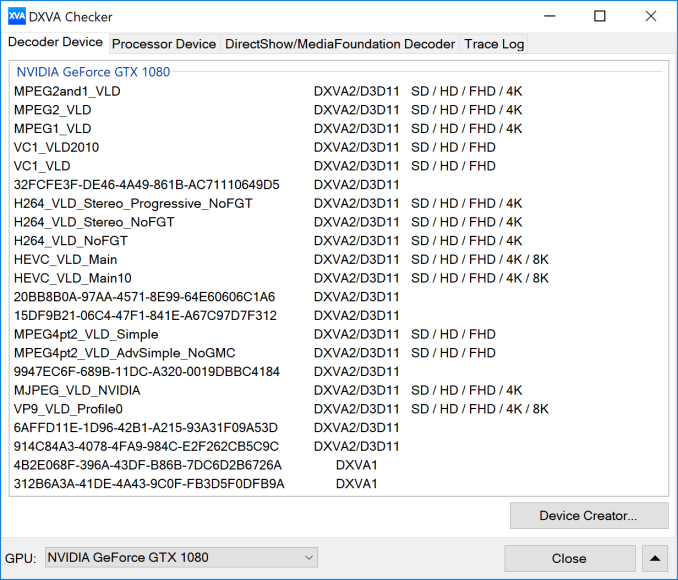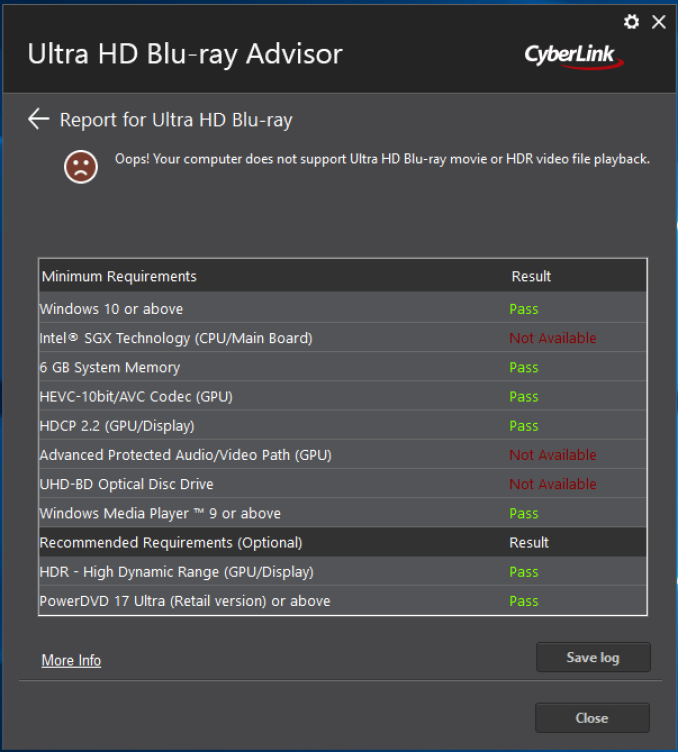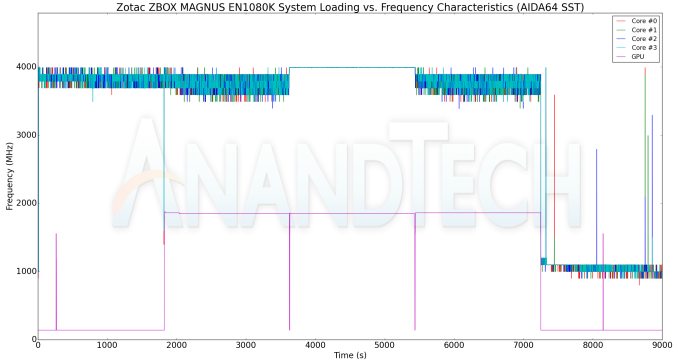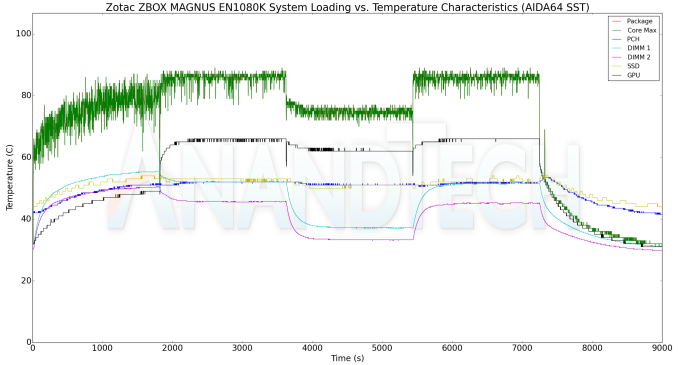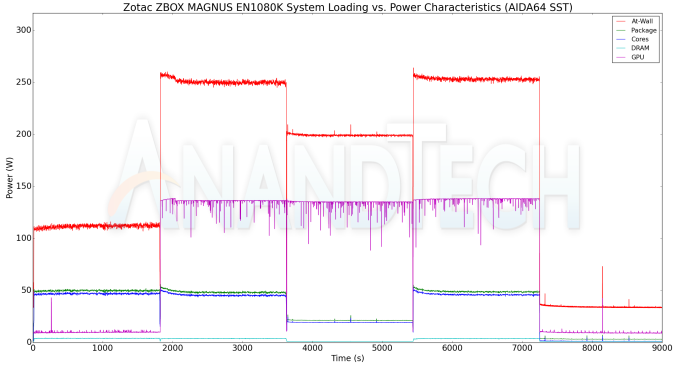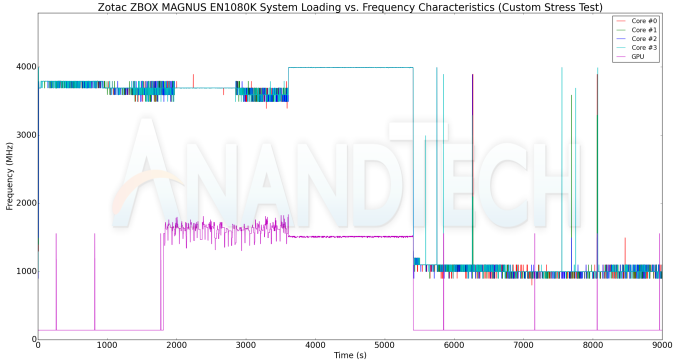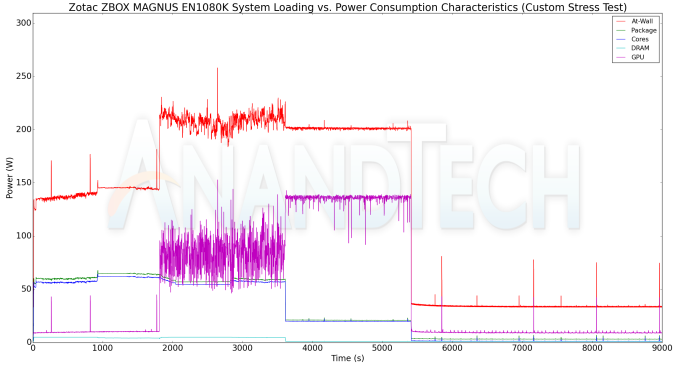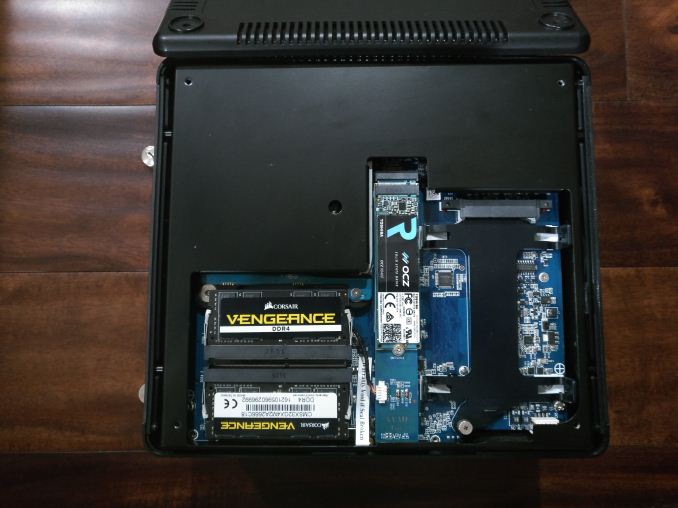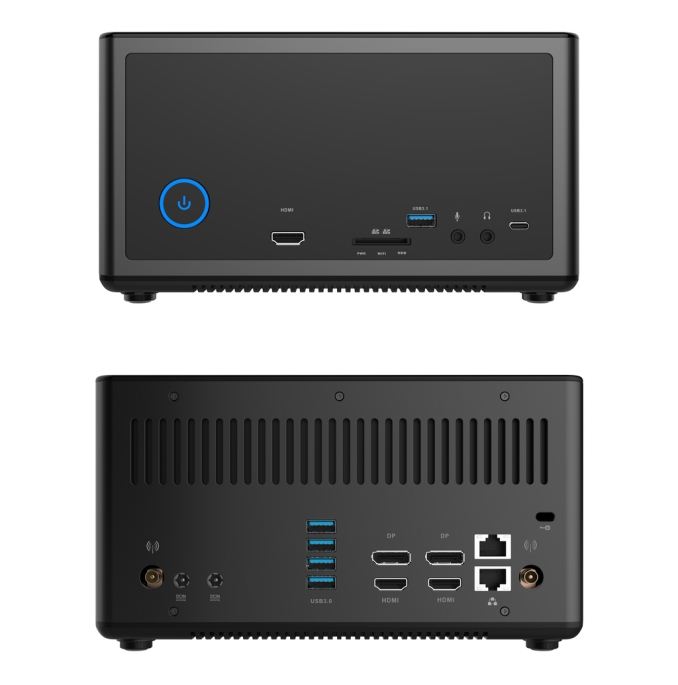
Original Link: https://www.anandtech.com/show/12201/zotac-zbox-magnus-en1080k-compact-gaming-pc-review
Zotac ZBOX MAGNUS EN1080K Compact Gaming PC Review
by Ganesh T S on January 2, 2018 8:00 AM EST
Gaming systems and small form-factor (SFF) PCs have emerged as bright spots in the desktop PC market that has been subject to severe challenges recently. Many vendors have tried to combine the two, but space constraints and power concerns have ended up limiting the gaming performance of such systems. Zotac, in particular, has been very active in this space with their ZBOX MAGNUS series. Starting with the ZBOX MAGNUS EN980 (Intel Core i5-6400 / GTX 980), they have been on a regular release cadence - in mid-2016, we saw the EN1080 with an updated Pascal GPU, and the CPU upgrade to Kaby Lake in the EN1080K came to market in Q3 2017.
The third-generation flagship ZBOX MAGNUS fixes some of the shortcomings that were identified in the EN1080 with respect to the system design. Main amongst them is the use of a better thermal solution for the M.2 SSD. We also have a CPU upgrade from Skylake to Kaby Lake (The Core i7-6700 is replaced by the Core i7-7700, while retaining the same B150 chipset). Based on these updates, the performance of the EN1080 and EN1080K should be quite similar, except for the benefits offered by the slightly faster clocks in the Kaby Lake CPU. In this review, we will take a look at the performance of the EN1080K and also determine the areas where Zotac can improve in the upcoming products in this lineup.
Introduction
The Zotac ZBOX MAGNUS EN1080K came into the market approximately 6 - 8 months after the release of the EN1080. The claims for the flagship have continued to be the same - a powerful VR-ready gaming mini-PC that is equipped with a high-end desktop CPU and GPU. In terms of physical footprint, the EN1080K continues to be the same as the previous versions (EN980 / EN1080) (5.85L / 225 mm x 203 mm x 128 mm ). Putting a high-end desktop CPU and GPU in that form factor with a liquid cooling system is technically impressive, and we have given the chassis and cooling system enough praise in the reviews for the EN980 and EN1080. The EN1080K retains the industrial design of the EN1080, with its front panel HDMI port to enable easy hook-up of VR systems. The fancy LED lighting (controllable via the Spectra utility) is also available.
In addition to the main unit, the PC package also includes two 180W (19.5V @ 9.23A) power bricks along with US power cords and two WLAN antennae. A quick start guide with installation instructions for the memory and disk drives, a user manual and a read-only USB key with the drivers round up the rest of the package.
We received the barebones version of the ZBOX MAGNUS EN1080K. In order to complete the build, we used the same components that were used in our EN1080 build - two 16GB Corsair Vengeance DDR4 SODIMMs and a 512GB Toshiba OCZ RD400 M.2 2280 PCIe 3.0 x4 NVMe SSD. The Corsair SODIMMs can operate at up to 2667 MHz, but, in the EN1080K, they are capped at 2400 MHz (compared to the 2133 MHz for the same SODIMMs in the EN1080). The Toshiba OCZ RD400 operates with the full PCIe 3.0 x4 bandwidth. Note that OCZ's custom NVMe driver is needed to obtain the best performance out of the SSD.
The specifications of our review configuration are summarized in the table below.
| Zotac ZBOX MAGNUS EN1080K Specifications | |
| Processor | Intel Core i7-7700 Kaby Lake-S, 4C/8T, 3.6 GHz (Turbo to 4.2 GHz), 14nm+, 8MB L2, 65W TDP |
| Memory | Corsair Vengeance CMSX32GX4M2A2666C18 DDR4 18-18-18-36 @ 2400 MHz 2x16 GB |
| Graphics | NVIDIA GeForce GTX 1080 (8GB GDDR5x) |
| Disk Drive(s) | Toshiba OCZ RD400 (512 GB; M.2 Type 2280 PCIe 3.0 x4 NVMe; Toshiba 15nm; MLC) |
| Networking | Intel Dual Band Wireless-AC 3165 (1x1 802.11ac - 433 Mbps) 2x Realtek RTL8168 Gigabit LAN |
| Audio | 3.5mm Headphone Jack Capable of 5.1/7.1 digital output with HD audio bitstreaming (HDMI) |
| Miscellaneous I/O Ports | 4x USB 3.0 2x USB 3.1 Gen 2 (1x Type-A + 1x Type-C) 1x SDXC Card Slot |
| Operating System | Retail unit is barebones, but we installed Windows 10 Enterprise FCU x64 |
| Pricing | $1700 (barebones, when reviewed) $2351 (as configured, No OS) |
| Full Specifications | Zotac ZBOX MAGNUS EN1080K Specifications |
Internally, the EN1080 / EN1080K uses the B150 chipset (compared to the H170 used in the EN980). However, given the configurability options (only the DRAM and SSD / HDDs are left to the end user to complete the hardware configuration), the choice of chipset really doesn't matter. Obviously, if Zotac were to go back to the specifications stage and look into more peripherals I/Os based off PCIe bridges, the B150's limited number of high-speed I/O lanes might be problematic.
In terms of the audio codec (Realtek ALC892), Wi-Fi (Intel AC3165), LAN controllers (2x Realtek RTL8168), USB 3.1 controller (ASMedia ASM1142), and the SDXC card reader (Realtek-based USB 2.0 bridge), the EN1080 and the EN1080K are the same.
In the table below, we have an overview of the various systems that we are comparing the Zotac ZBOX MAGNUS EN1080K against. Note that they may not belong to the same market segment. The relevant configuration details of the machines are provided so that readers have an understanding of why some benchmark numbers are skewed for or against the Zotac ZBOX MAGNUS EN1080K when we come to those sections. Note that we are using a new updated benchmark suite, and the number of benchmarks with comparison points is limited.
| Comparative PC Configurations | ||
| Aspect | Zotac ZBOX MAGNUS EN1080K | |
| CPU | Intel Core i7-7700 | Intel Core i7-7700 |
| GPU | NVIDIA GeForce GTX 1080 (8 GB) | NVIDIA GeForce GTX 1080 (8 GB) |
| RAM | Corsair Vengeance CMSX32GX4M2A2666C18 DDR4 18-18-18-36 @ 2400 MHz 2x16 GB |
Corsair Vengeance CMSX32GX4M2A2666C18 DDR4 18-18-18-36 @ 2400 MHz 2x16 GB |
| Storage | Toshiba OCZ RD400 (512 GB; M.2 Type 2280 PCIe 3.0 x4 NVMe; Toshiba 15nm; MLC) |
Toshiba OCZ RD400 (512 GB; M.2 Type 2280 PCIe 3.0 x4 NVMe; Toshiba 15nm; MLC) |
| Wi-Fi | Intel Dual Band Wireless-AC 3165 (1x1 802.11ac - 433 Mbps) |
Intel Dual Band Wireless-AC 3165 (1x1 802.11ac - 433 Mbps) |
| Price (in USD, when built) | $1700 (barebones) $2351 (as configured, No OS) |
$1700 (barebones) $2351 (as configured, No OS) |
Performance Metrics - I
The Zotac ZBOX MAGNUS EN1080K was evaluated using our standard test suite for low power desktops / industrial PCs. Not all benchmarks were processed on all the machines due to updates in our testing procedures. Therefore, the list of PCs in each graph might not be the same. In the first section, we will be looking at SYSmark 2014 SE, as well as some of the Futuremark benchmarks.
BAPCo SYSmark 2014 SE
BAPCo's SYSmark 2014 SE is an application-based benchmark that uses real-world applications to replay usage patterns of business users in the areas of office productivity, media creation and data/financial analysis. In addition, it also addresses the responsiveness aspect which deals with user experience as related to application and file launches, multi-tasking etc. Scores are meant to be compared against a reference desktop (the SYSmark 2014 SE calibration system in the graphs below). While the SYSmark 2014 benchmark used a Haswell-based desktop configuration, the SYSmark 2014 SE makes the move to a Lenovo ThinkCenter M800 (Intel Core i3-6100, 4GB RAM and a 256GB SATA SSD). The calibration system scores 1000 in each of the scenarios. A score of, say, 2000, would imply that the system under test is twice as fast as the reference system.
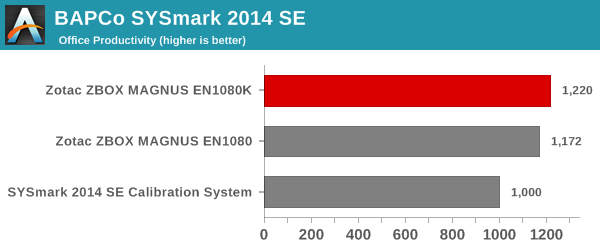
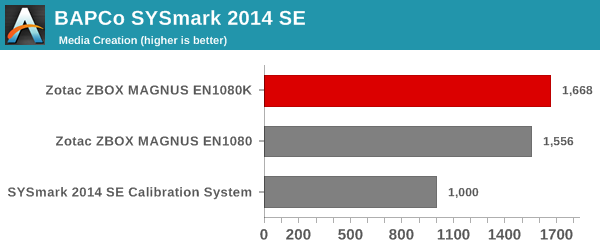
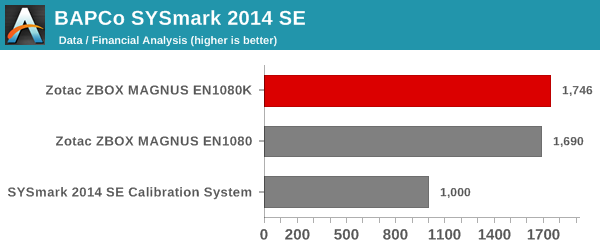
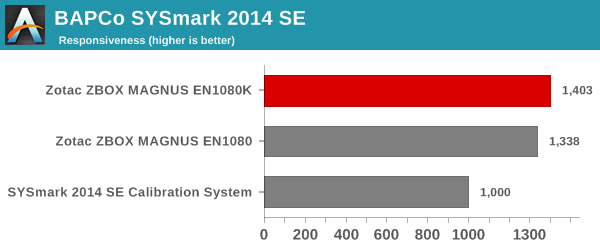
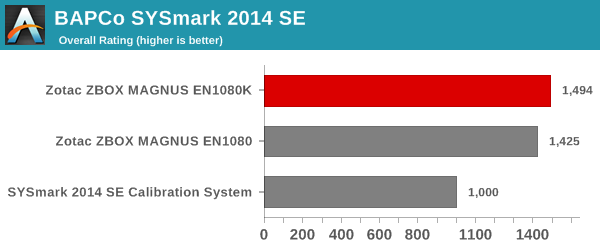
SYSmark 2014 SE also adds energy measurement to the mix. A high score in the SYSmark benchmarks might be nice to have, but, potential customers also need to determine the balance between power consumption and the efficiency of the system. For example, in the average office scenario, it might not be worth purchasing a noisy and power-hungry PC just because it ends up with a 2000 score in the SYSmark 2014 SE benchmarks. In order to provide a balanced perspective, SYSmark 2014 SE also allows vendors and decision makers to track the energy consumption during each workload. In the graphs below, we find the total energy consumed by the PC under test for a single iteration of each SYSmark 2014 SE workload and how it compares against the calibration systems.
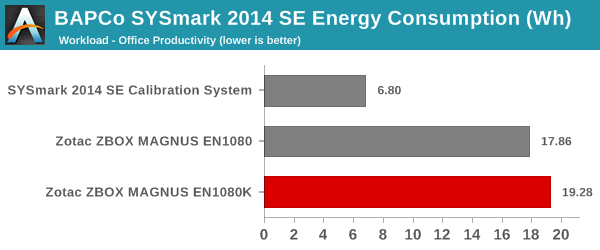

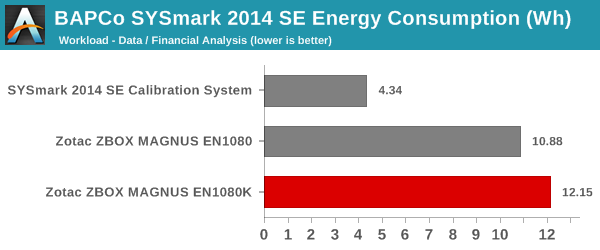
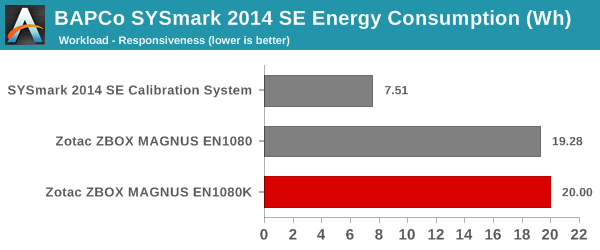

As expected, the clock speed boost of the Core i7-7700 over the Core i7-6700 helps the EN1080K deliver better benchmark numbers compared to the EN1080 across all the workloads. However, it does come at the cost of increased energy consumption (some of which can be attributed to the faster memory clock also).
Futuremark PCMark 10
UL's PCMark 10 evaluates computing systems for various usage scenarios (generic / essential tasks such as web browsing and starting up applications, productivity tasks such as editing spreadsheets and documents, gaming, and digital content creation). We benchmarked select PCs with the PCMark 10 Extended profile and recorded the scores for various scenarios. These scores are heavily influenced by the CPU and GPU in the system, though the RAM and storage device also play a part. The power plan was set to Balanced for all the PCs while processing the PCMark 10 benchmark.
PCMark 10 is a new addition to our benchmark suite, and our list of SFF systems with recorded scores is just getting started. We only have the Core i7-6700HQ-based Skull Canyon to compare against. The Core i7-7700 with the much faster clocks and higher TDP, as well as a GPU that is miles ahead (NVIDIA GTX 1080 vs. Intel Iris Pro Graphics 580) enable the EN1080K to easily outscore the NUC6i7KYK.
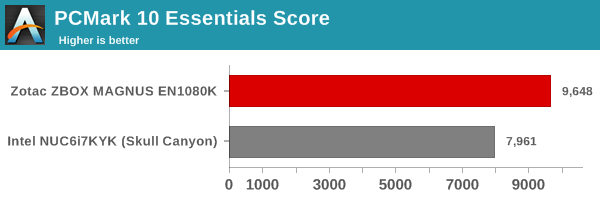

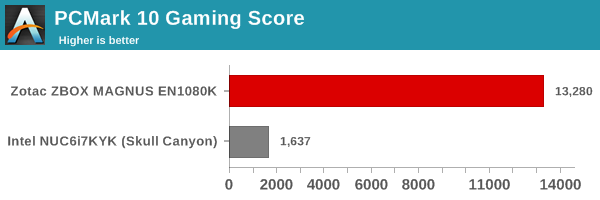
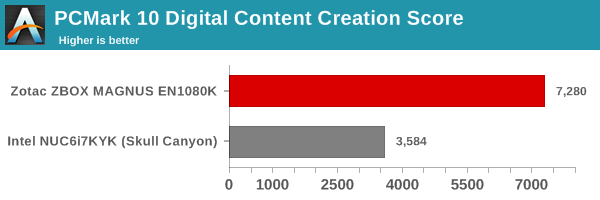
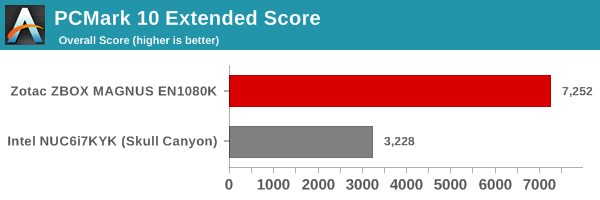
Futuremark PCMark 8
We continue to present PCMark 8 benchmark results (as those have more comparison points) while our PCMark 10 scores database for systems grows in size. PCMark 8 provides various usage scenarios (home, creative and work) and offers ways to benchmark both baseline (CPU-only) as well as OpenCL accelerated (CPU + GPU) performance. We benchmarked select PCs for the OpenCL accelerated performance in all three usage scenarios. These scores are heavily influenced by the CPU in the system. The EN1080K outscores the EN1080 on almost all of these benches.
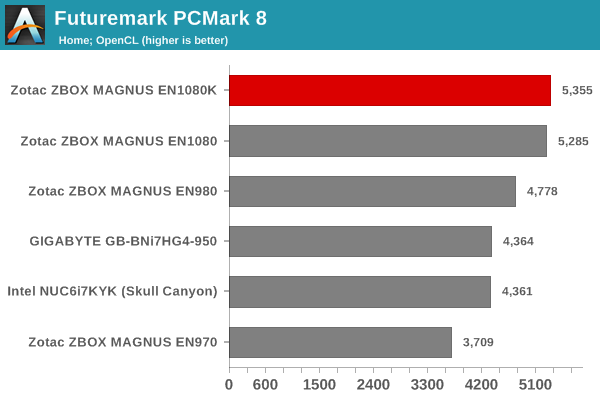

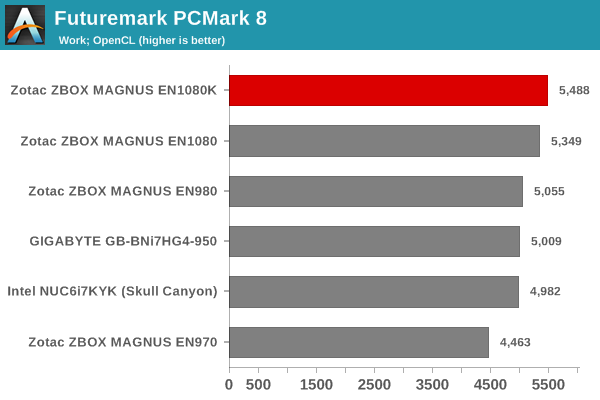
Miscellaneous Futuremark Benchmarks
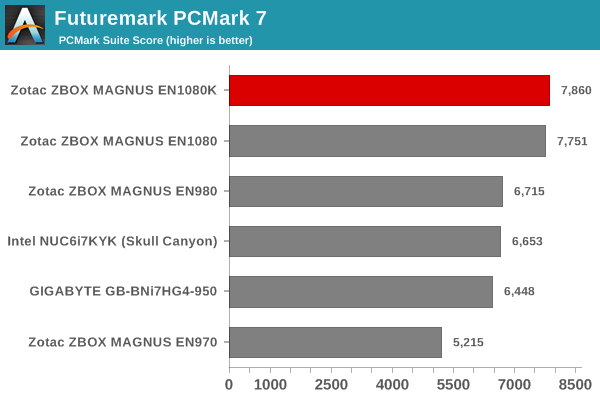
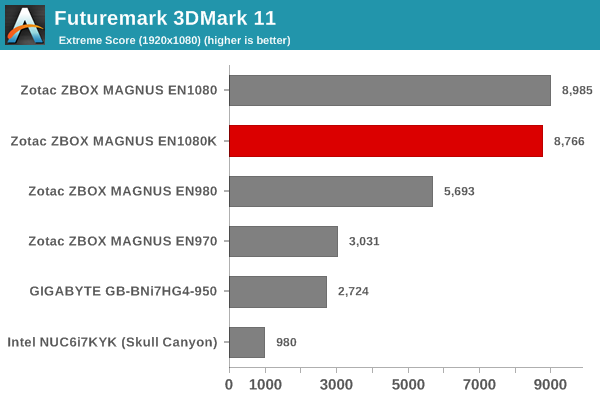

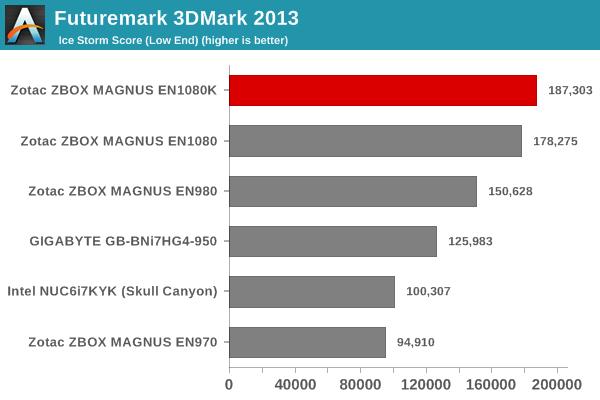
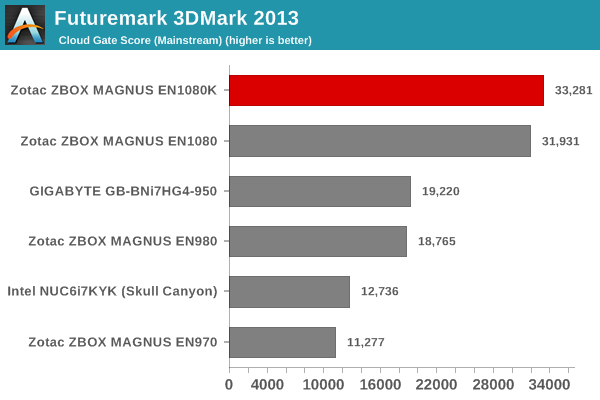
3D Rendering - CINEBENCH R15
We have moved on from R11.5 to R15 for 3D rendering evaluation. CINEBENCH R15 provides three benchmark modes - OpenGL, single threaded and multi-threaded. Evaluation of select PCs in all three modes provided us the following results. As expected, the EN1080K comes out on top in all modes.

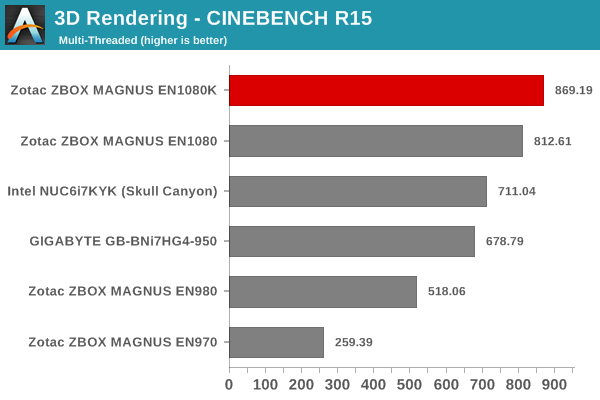
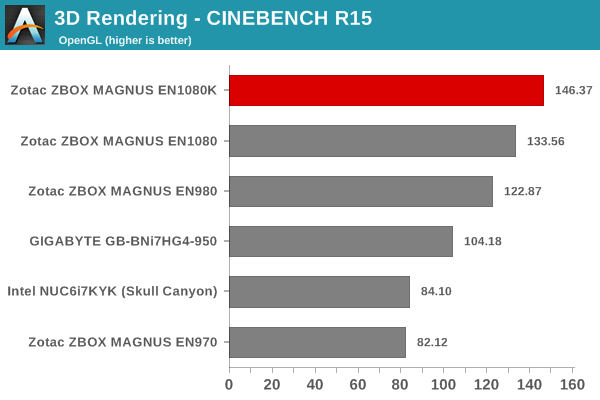
Performance Metrics - II
In this section, we mainly look at benchmark modes in programs used on a day-to-day basis, i.e, application performance and not synthetic workloads.
x264 Benchmark
First off, we have some video encoding benchmarks courtesy of x264 HD Benchmark v5.0. This is simply a test of CPU performance. As expected, the Core i7-7700 comes out on top. Recent releases of the x264 benchmark can show even more impressive gains, as they make use of the latest and greatest features of the modern Intel processors.
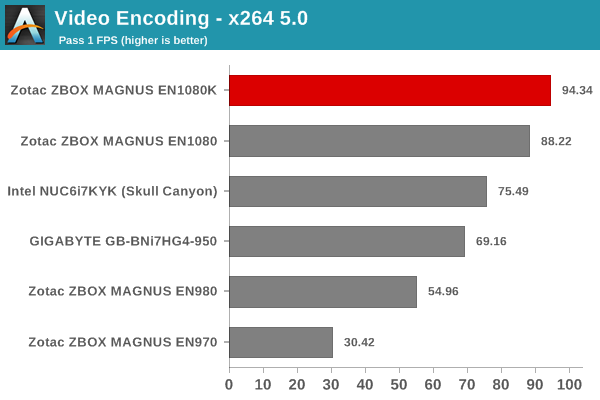
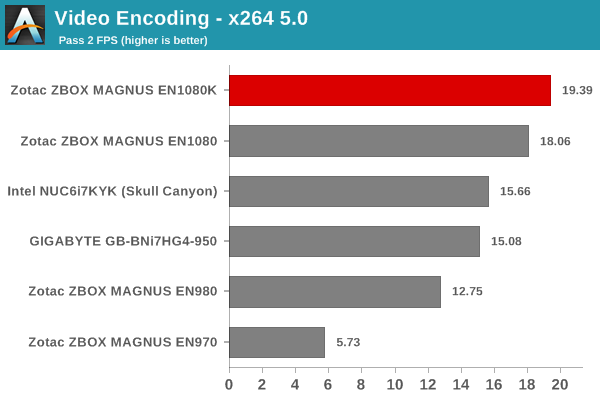
7-Zip
7-Zip is a very effective and efficient compression program, often beating out OpenCL accelerated commercial programs in benchmarks even while using just the CPU power. 7-Zip has a benchmarking program that provides tons of details regarding the underlying CPU's efficiency. In this subsection, we are interested in the compression and decompression MIPS ratings when utilizing all the available threads.

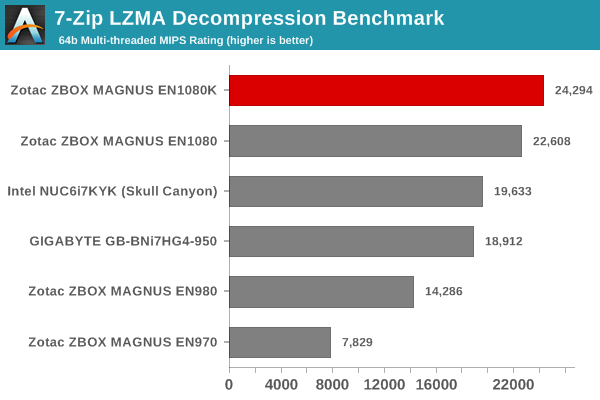
TrueCrypt
As businesses (and even home consumers) become more security conscious, the importance of encryption can't be overstated. CPUs supporting the AES-NI instruction for accelerating the encryption and decryption processes have become more widespread over the last few years. TrueCrypt, a popular open-source disk encryption program can take advantage of the AES-NI capabilities. The TrueCrypt internal benchmark provides some interesting cryptography-related numbers to ponder. In the graph below, we can get an idea of how fast a TrueCrypt volume would behave in the Zotac ZBOX MAGNUS EN1080K and how it would compare with other select PCs. This is a purely CPU feature / clock speed based test.

Agisoft Photoscan
Agisoft PhotoScan is a commercial program that converts 2D images into 3D point maps, meshes and textures. The program designers sent us a command line version in order to evaluate the efficiency of various systems that go under our review scanner. The command line version has two benchmark modes, one using the CPU and the other using both the CPU and GPU (via OpenCL). We have been using an old version of the program with 50 photogaphs in our reviews till now. The updated benchmark (v1.3) now takes around 84 photographs and does four stages of computation:
- Stage 1: Align Photographs (capable of OpenCL acceleration)
- Stage 2: Build Point Cloud (capable of OpenCL acceleration)
- Stage 3: Build Mesh
- Stage 4: Build Textures
We record the time taken for each stage. Since various elements of the software are single threaded, others multithreaded, and some use GPUs, it is interesting to record the effects of CPU generations, speeds, number of cores, DRAM parameters and the GPU using this software.
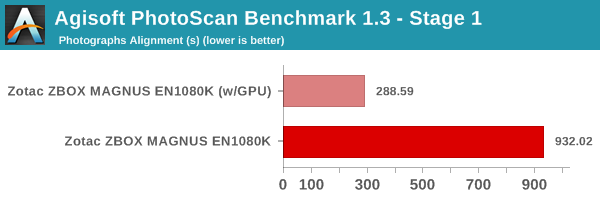
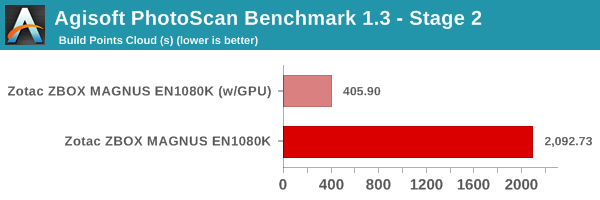
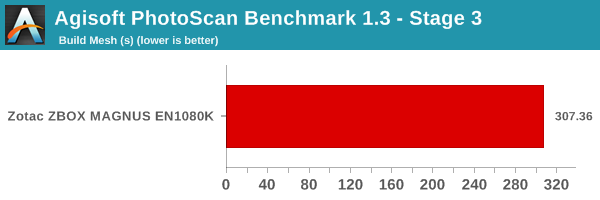
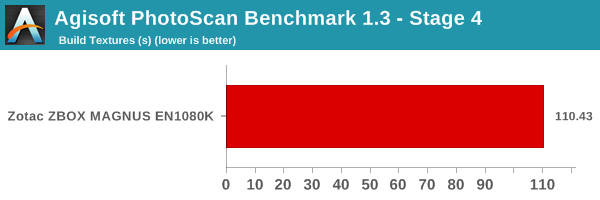
Dolphin Emulator
Wrapping up our application benchmark numbers is the new Dolphin Emulator (v5) benchmark mode results. This is again a test of the CPU capabilities. We do not have multiple data points yet to have a proper understanding of the results of this benchmark.
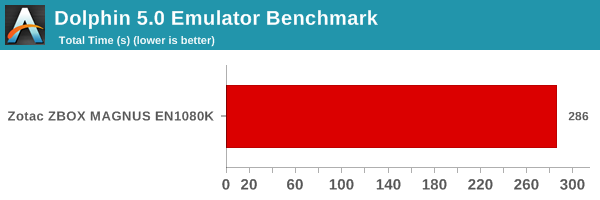
Gaming Benchmarks
The gaming credentials of the NVIDIA GeForce GTX 1080 are quite impressive. It is a bonafide high-end desktop GPU in the NVIDIA Pascal series (GP204). The version in the MAGNUS EN1080K, like the one in the EN1080, is not crippled in any way despite the size of the unit. The GPU should easily be able to support 4K gaming and meet the requirements for VR headsets.
For the purpose of benchmarking, we chose four different games (Sleeping Dogs, Tomb Raider, Bioshock Infinite and DiRT Showdown) at three different quality levels. Note that the main aim here is not to show that the GTX 1080 can play the latest and greatest games (which it can do). Rather, it is to compare the ZBOX MAGNUS EN1080 against other gaming-focused mini-PCs that we have evaluated before.
Sleeping Dogs
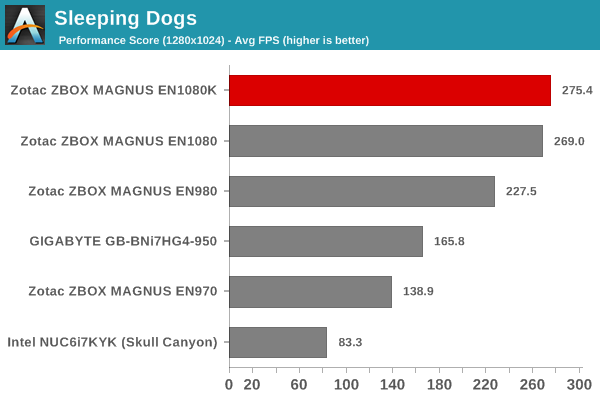
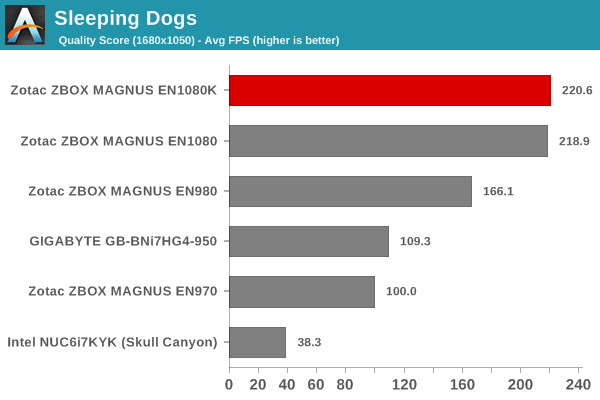
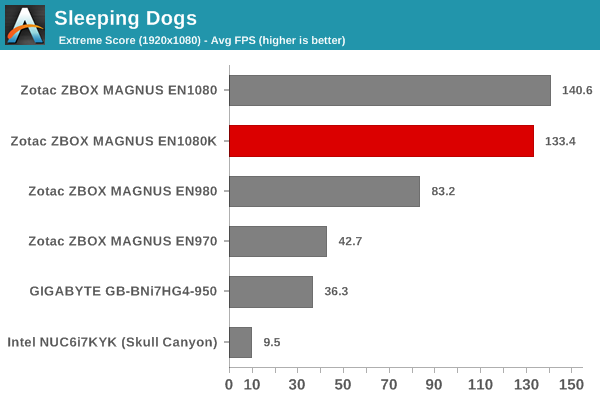
Tomb Raider

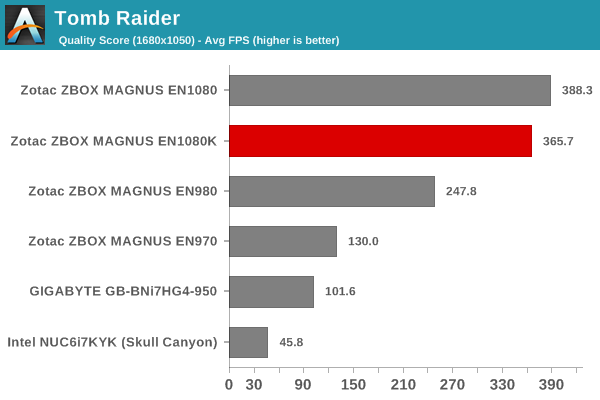
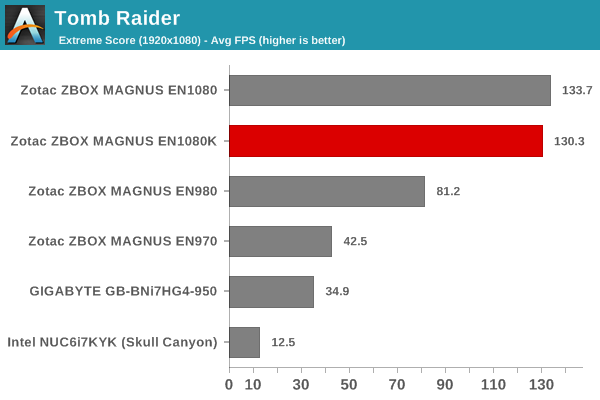
Bioshock Infinite
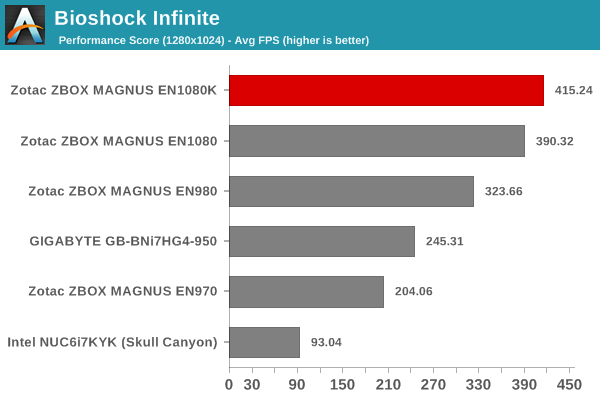
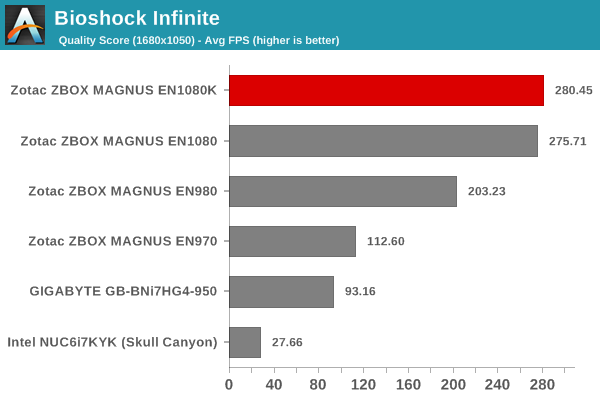

DiRT Showdown
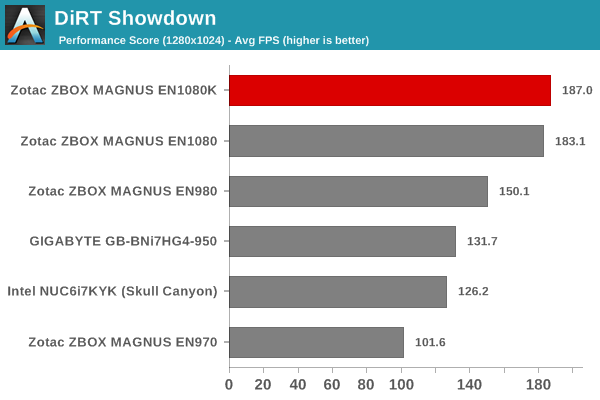
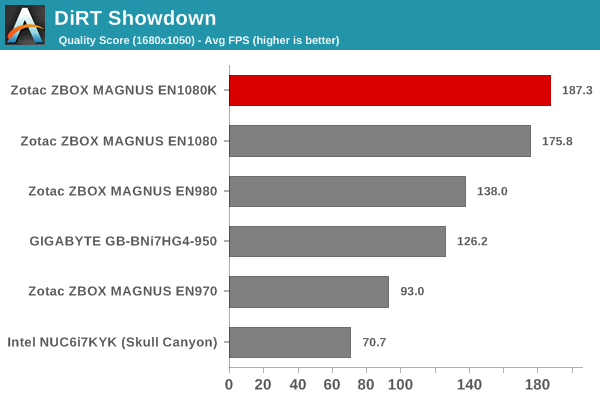
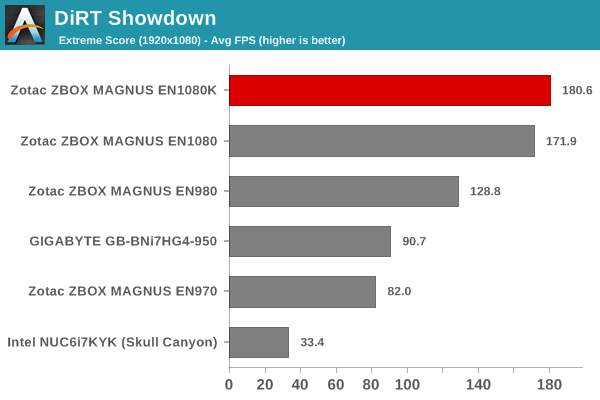
The Talos Principle
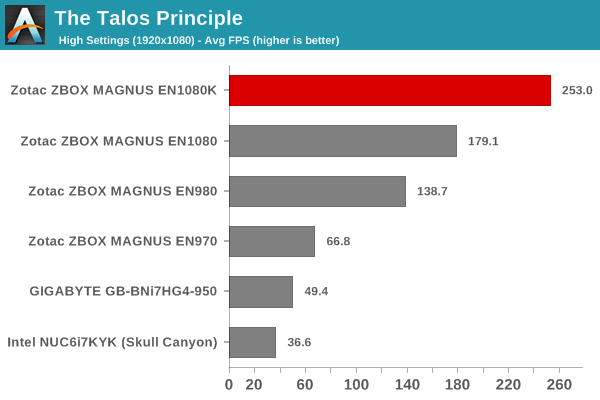
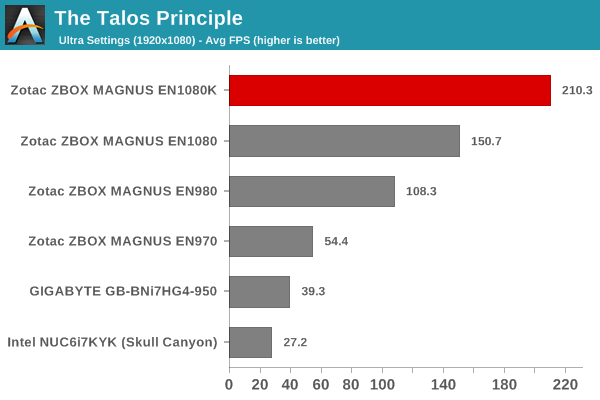
GRID Autosport
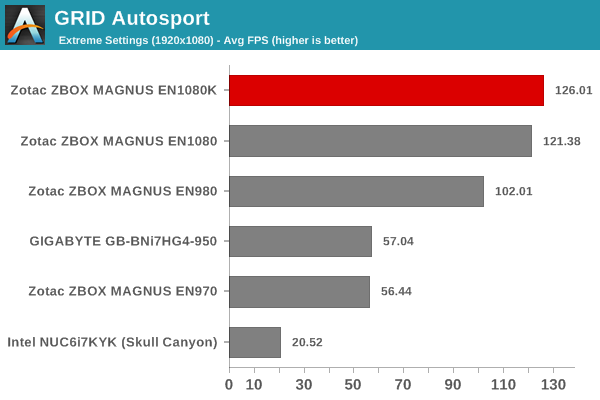
As expected, the little bit extra grunt afforded by the faster clocks in the CPU helps in some of the games. Otherwise, almost all of the benchmark numbers of the EN1080 and EN1080K are within the permissible variations between different runs.
Gaming Notebooks Compared
One of the most common comments posted in response to mini-PC reviews is that the value proposition of an equivalent notebook is much higher than that of the PC. While there are plenty of factors that might make this comparison invalid, we thought it would be interesting to see how the Zotac ZBOX MAGNUS EN1080K fares against premium gaming notebooks. Towards this, we borrowed a few benchmarks from our notebook reviews and processed them on the EN1080K. In the graphs below, we also have the gaming mini-PCs on which the benchmarks were processed. First, we will look at some artificial benchmarks before moving on to the games themselves.
3DMark Revisited
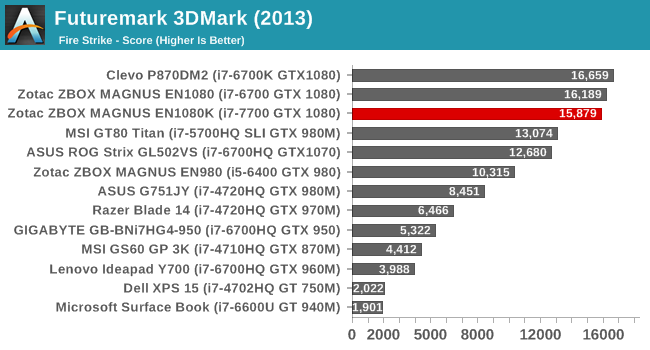
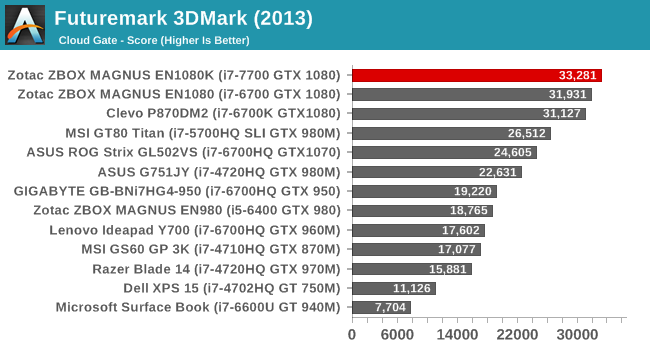
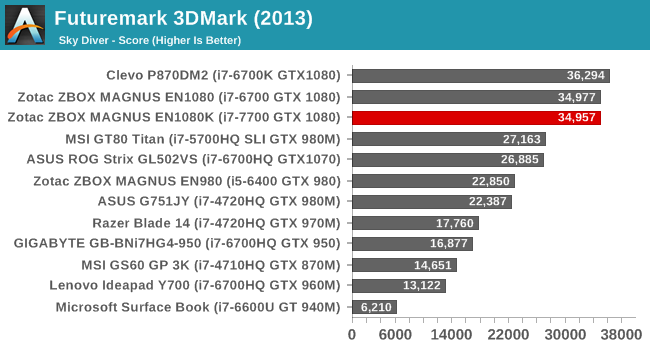
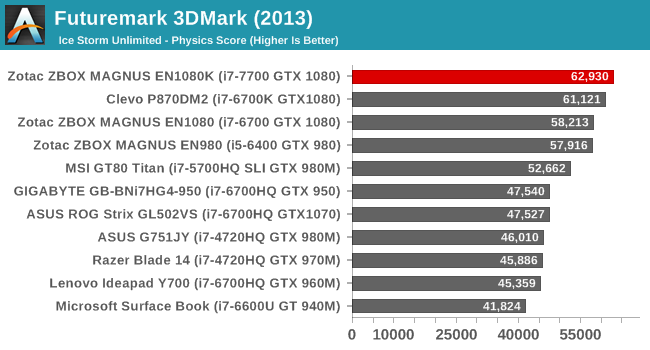
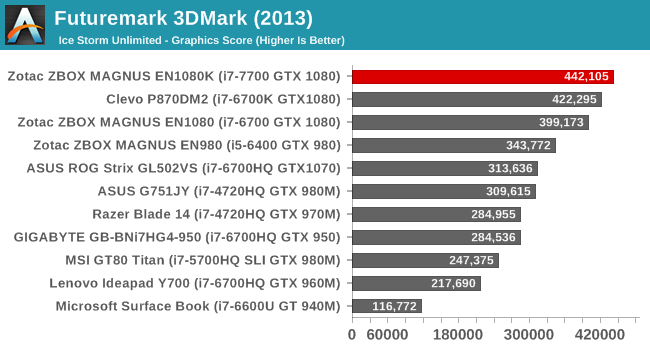

GFXBench


Dota 2
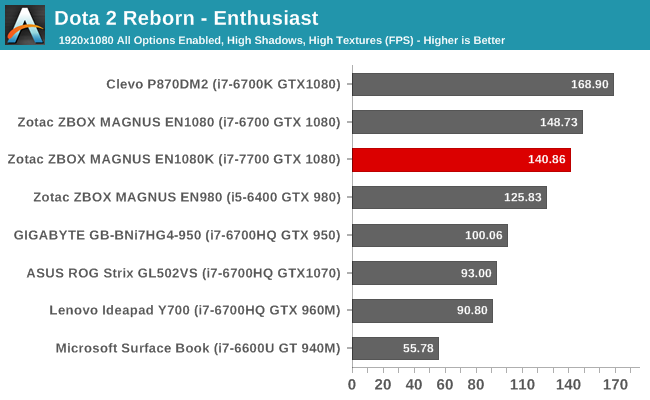
Middle Earth: Shadow of Mordor
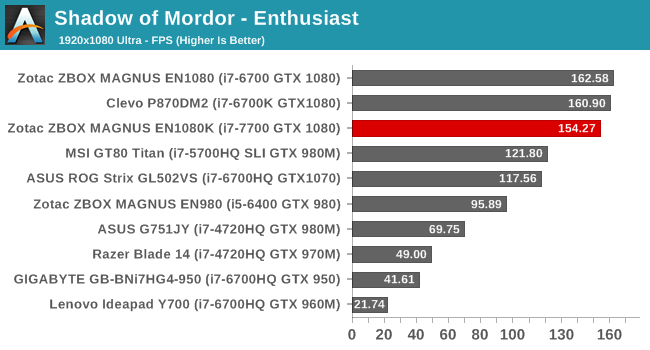
The takeaway from these results is that the performance of the ZBOX MAGNUS EN1080K and the EN1080K is beaten only by the Clevo desktop replacement (DTR) notebook that uses the same GPU, but, with a 91W Core i7-6700K, instead of the 65W Core i7-7700. This gives the Clevo DTR an edge in the benchmarks that also depend on the CPU performance.
Networking and Storage Performance
Networking and storage are two major aspects which influence our experience with any computing system. This section presents results from our evaluation of these aspects in the Zotac ZBOX MAGNUS EN1080K. On the storage side, one option would be repetition of our strenuous SSD review tests on the drive(s) in the PC. Fortunately, to avoid that overkill, Futuremark's PCMark 8 has a storage bench where certain common workloads such as loading games and document processing are replayed on the target drive. Results are presented in two forms, one being a benchmark number and the other, a bandwidth figure. We ran the PCMark 8 storage bench on selected PCs and the results are presented below.
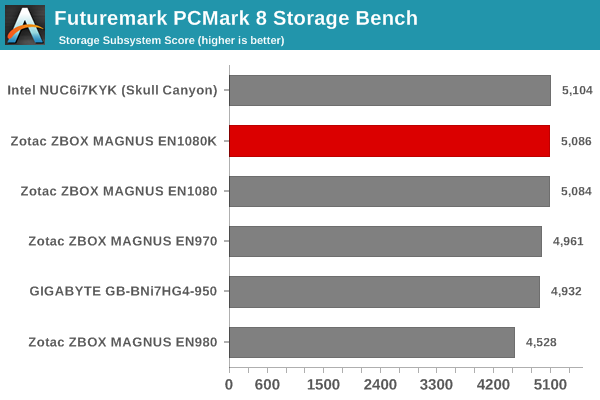

As expected, the EN1080K performs similar to the EN1080 since we are using the same Toshiba OCZ RD400 in both builds. It is not the fastest PCIe SSD around, but, is a definite step up from all the SATA SSDs we have used in some of the previously evaluated systems.
On the networking side, we restricted ourselves to the evaluation of the WLAN component. Our standard test router is the Netgear R7000 Nighthawk configured with both 2.4 GHz and 5 GHz networks. The router is placed approximately 20 ft. away, separated by a couple of drywalls (as in a typical US building). A wired client is connected to the R7000 and serves as one endpoint for iperf evaluation. The PC under test is made to connect to either the 5 GHz (preferred) or 2.4 GHz SSID and iperf tests are conducted for both TCP and UDP transfers. It is ensured that the PC under test is the only wireless client for the Netgear R7000. We evaluate total throughput for up to 32 simultaneous TCP connections using iperf and present the highest number in the graph below.
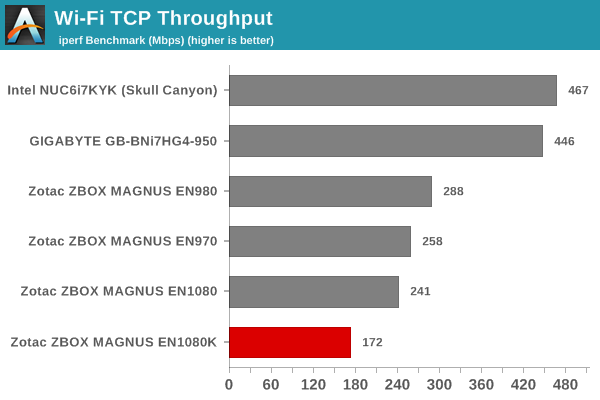
In the UDP case, we try to transfer data at the highest rate possible for which we get less than 1% packet loss.
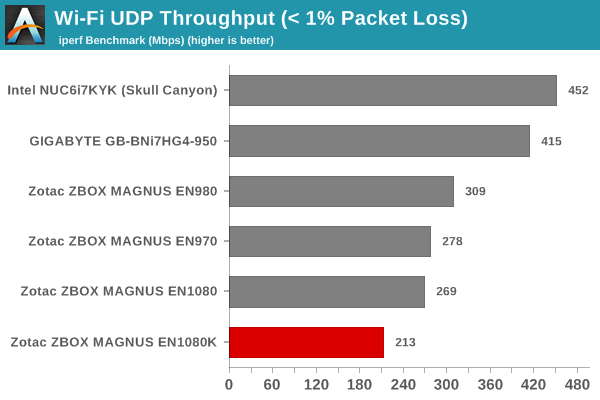
We need to clarify one important aspect in the above graphs. The numbers for both the EN1080 and the EN1080K should be similar. However, due to a recent change in the lab environment for the PCs, we are no longer able to recreate the same WLAN testing environment for the new PCs. As we evaluate more systems, we will phase out the results derived with the older setup. That said, the comparison of the relative numbers is still valid. The 1x1 802.11ac radio is not a great choice for a flagship system, but, it is somewhat made up for by the dual gigabit LAN ports.
4K HTPC Credentials
The ZBOX MAGNUS EN980 and EN1080 impressed us with their noise profile for HTPC duties. The ZBOX MAGNUS EN1080K is similar to the EN1080 with respect to this aspect. Liquid cooling enables the fans to operate at very low speeds compared to the regular heat sink and blower combinations used in other mini-PCs. Obviously, the unit is not for the discerning HTPC enthusiast who is better off with a passively cooled system.
We already gave a brief introduction to the HTPC potential of the ZBOX MAGNUS EN1080K in our 2017 HTPC Components guide. In this section, we provide additional elaboration on the system's 4K HTPC credentials. All the testing in this section was done with the EN1080K hooked up to a TCL 55P607 through a Denon AVR X3400H receiver.
Refresh Rate Accuracy
Starting with Haswell, Intel, AMD and NVIDIA have been on par with respect to display refresh rate accuracy. The most important refresh rate for videophiles is obviously 23.976 Hz (the 23 Hz setting). As we have come to expect from NVIDIA, the default refresh rate accuracy is not that great, though they do allow fine-tuning of the refresh rate unlike other GPU vendors.
The gallery below presents some of the other refresh rates that we tested out (including custom resolutions for 25 Hz and 50 Hz). The first statistic in madVR's OSD indicates the display refresh rate.
Network Streaming Efficiency
Evaluation of OTT playback efficiency was done by playing back the Mystery Box's Peru 8K HDR 60FPS video in YouTube using Microsoft Edge and Season 4 Episode 4 of the Netflix Test Pattern title using the Windows Store App.
The YouTube streaming test played back the 4K non-HDR version (VP9 video and Opus audio), while the Netflix one delivered the 16 Mbps HEVC HDR10 version.
The graph below shows the power consumption at the wall and the GPU loading parameters for the YouTube streaming case. Initially, the power consumption is a bit high as the video is fetched at a lower resolution (less VPU load), but, needs to be scaled up for display. Later on, as the buffering stabilizes, the power consumption (around 58W) and the GPU / VPU load (6% / 50%) also stabilizes.
A similar graph for the Netflix streaming case is also presented below. Manual stream selection is available (Ctrl-Alt-Shift-S) and debug information / statistics can also be viewed (Ctrl-Alt-Shift-D). Statistics collected for the YouTube streaming experiment were also collected here.
It must be noted that the debug OSD is kept on till the stream reaches the 16 Mbps playback stage around 2 minutes after the start of the streaming. Toggling the state of the debug OSD results in significant variation in the at-wall power consumption (as much as 15W) and GPU loading parameters. In the steady state, we find that the GPU load is around 12%, while the VPU load is around 38%. The power consumption is around 78W.
Decoding and Rendering Benchmarks
In order to evaluate local file playback, we concentrate on Kodi (for the casual user) and madVR (for the HTPC enthusiast). Under madVR, we decided to test out only the default out-of-the-box configuration. We recently revamped our decode and rendering test suite, as described in our 2017 HTPC components guide.
madVR 0.92.10 was evaluated with MPC-HC 1.7.13 and LAV Filters 0.70.1-83. The vide decoder was set to Direct 3D mode.
The GPU usage (around 30 - 40%, irrespective of the stream being decoded) is mainly related to the scaling required to play back the videos at 4K resolution. The decoder load is very less for 480i - 1080p streams - of the order of 5% to 20%. 4K videos load the video processing unit at 30% - 50%. The VP9 Profile 2 video doesn't have hardware accelerated decoding, and that shows in the at-wall power consumption. While the 4Kp60 HEVC 10-bit video was decoded with less than 70W at the wall, the VP9 Profile 2 video with the same resolution and frame rate requires upwards of 120W. We see similar behavior with Kodi 17.6, as shown in the graphs below.
Frame drops are evident whenever the GPU load consistently stays above the 85 - 90% mark, or, the video processing unit gets fully loaded. We have neither case happening. The Zotac ZBOX MAGNUS EN1080K should be able to handle any video stream thrown at it, even if there is no hardware acceleration available.
Moving on to the codec support, the GTX 1080 is a known quantity with respect to the scope of supported hardware accelerated codecs. DXVA Checker serves as a confirmation.
The only odd aspect is the absence of VP9 Profile 2 hardware decoding (used in the YouTube HDR streams).
Concluding the HTPC section, we take a look at the output of the Ultra HD Blu-ray Advisor tool from CyberLink.
We see that the system can't play back Ultra HD Blu-rays even if a UHD Blu-ray drive were to be attached to it. The main reasons are the absence of SGX support and the inability to make use of the Intel GPU's protected audio-video path for processing the Blu-ray streams.
Power Consumption and Thermal Performance
The power consumption of the Zotac ZBOX MAGNUS EN1080K at the wall was measured with a 4K display (LG 43UD79B) being driven through one of its DisplayPort outputs. In the graphs below, we compare the idle and load power of the Zotac ZBOX MAGNUS EN1080K with other gaming mini-PCs evaluated before. For load power consumption, we ran our own custom stress test (Prime95 and FurMark) as well as the AIDA64 System Stability Test with various stress components, and noted the maximum sustained power consumption at the wall.
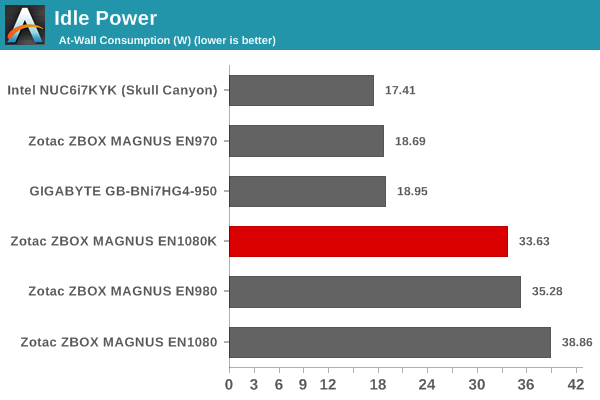
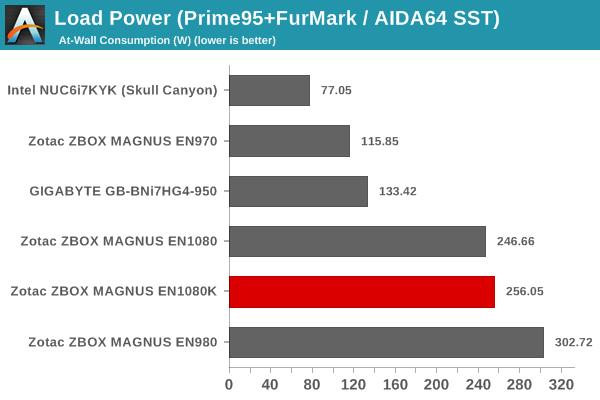
Despite the use of a NVMe SSD (compared to a SATA SSD) in the EN1080K (compared to the EN980), the former manages to have the lowest idling power consumption amonst all the three high-end flagship gaming SFF PCs. The benefits of Kaby Lake over Skylake are evident here. On the load side, we find that the EN1080K is slightly worse than the EN1080, but, the system correspondigly delivers better performance too.
Our thermal stress routine starts with the system at idle, followed by four stages of different system loading profiles using the AIDA64 System Stability Test (each of 30 minutes duration). In the first stage, we stress the CPU, caches and RAM. In the second stage, we add the GPU to the above list. In the third stage, we stress the GPU standalone. In the final stage, we stress all the system components (including the disks). Beyond this, we leave the unit idle in order to determine how quickly the various temperatures in the system can come back to normal idling range. The various clocks, temperatures and power consumption numbers for the system during the above routine are presented in the graphs below.
We repeated the same observations with our legacy stress test using the latest versions of Prime95 and Furmark.
The CPU and GPU idle at less than 30 C, which shows the excellent nature of the thermal solution. The SSD idles around 42 C (compared to the 60 C for the same SSD in the EN1080), showing that Zotac has indeed managed to address the thermal concerns for M.2 drives in the chassis design. Other than that, we find that the CPU and GPU load temperatures do not cross 90 C, and there is no throttling at play (to be expected with the active cooling solution).
Concluding Remarks
The preceding pages have clearly shown that the Zotac ZBOX MAGNUS EN1080K delivers great performance despite its compact footprint. With the Core i7-7700, it can perform as well as any custom-built desktop rig with a 65W TDP CPU. On the GPU side, it can only be bettered by systems with SLI GPUs. Performance wise,the EN1080K should be able to tick all the boxes. The barebones pricing is also slightly lower than the launch price of the EN1080. However, the RAM and flash prices have gone up in the meanwhile, making our EN1080 and EN1080K builds almost the same in price. In any case, it is clear that Zotac is competing against desktop PCs from boutique PC vendors at this price point, and we have to say they are doing quite an effective job.
Note the raised M.2 slot (compared to the EN1080's M.2 slot) that allows the SSD to make contact with the underside of the chassis and dissipate heat via conduction
We previously talked briefly about how the 3rd generation system addresses some shortcomings of the previous flagship MAGNUS units, and it warrants repeating - the thermal solution for M.2 SSDs has improved significantly. Kaby Lake is also able to deliver idle power benefits, while boosting the possible peak performance. In effect, the EN1080K deserves all the praise that the EN1080 received, and more.
Though Zotac has addressed the M.2 thermals issue, some of our other feedback points from the EN1080 review still stand. A PCIe bridge for the SDXC slot instead of the USB 2.0 bridge (this can improve speeds with the latest UHS-II cards capable of operating at more than 150 MBps), and a 2x2 Wi-Fi radio (in fact, we are ready to sacrifice one of the two LAN ports for a 2x2 radio) would increase the appeal of the unit. It would also be nice to have a couple more USB 3.0 Type-A ports on the sides of the chassis, or, in the front panel. It would not be a bad idea to convert a couple of the USB 3.0 ports in the rear to USB 2.0 (as they probably get used for the keyboard and/or the mouse), while shifting the USB 3.0 ports to a more accessible place. We would also like Zotac to explore internal PSUs without incurring a significant penalty in the chassis size. The usage of two power bricks might not be amenable to all usage scenarios.
Unfortunately, there have also been some changes in the PC ecosystem since the introduction of the EN1080. In order to be worthy of flagship status, systems need to incorporate more features, and support emerging use-cases. The list of features that we would like Zotac to tackle in upcoming iterations are listed below:
- Addition of SGX support to the BIOS
- Replacement of the ASM1142 USB 3.1 Gen 2 daughterboard with integrated Thunderbolt 3
- Enabling usage of the Intel iGPU in the BIOS
- Addition of a display output from the Intel iGPU with HDMI 2.0 / HDCP 2.2 capabilities.
SGX is needed to support features of some softwares such as CyberLink PowerDVD 17. This is also related to the enabling of the Intel iGPU as well as the addition of a HDMI 2.0 / HDCP 2.2 port from it - these are necessary for PowerDVD 17 to be able to play back Ultra HD Blu-ray titles, when an optical Blu-ray drive is attached to the system.
On the whole, the Zotac ZBOX MAGNUS EN1080K is a powerful product with features and performance not available in any other PC of its size. Similar to the EN1080, its pricing is competitive when compared against corresponding offerings from boutique PC vendors.

